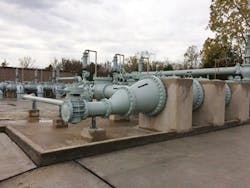Sims Bayou begins near Missouri City, Texas, and continues northeast until it reaches Buffalo Bayou. As a result of the Federal Flood Damage Reduction Project partnership between the U.S. Army Corps of Engineers and the Harris County Flood Control District, the bayou recently underwent significant flood control improvements, including widening 19.3 miles of Sims Bayou. Residents of neighborhoods adjacent to Sims Bayou now have a lower risk of flooding than in the past and are benefiting from the project.
The Sims Bayou project was designed and constructed in an environmentally responsible manner, and an increasing number of birds and other wildlife already can be seen along completed segments of the bayou and at storm water detention basins.
As part of the project, a new sanitary sewer lift station with a current capacity of 33.12 million gal per day (mgd) and an ultimate capacity of 42 mgd, was built for the city of Houston. The project was not without its challenges.
First, the large variation in influent flow rate required that pumps be sized to accommodate an average dry weather flow of 3.08 mgd, an average wet weather flow of 7.6 mgd and a peak two-hour flow rate of 41.5 mgd. A single pump must accommodate the average dry weather flow and the combined pumps must accommodate the 41.5 mgd, a flow variation that represents a peaking factor of 13.5. The pumps, individually and collectively, must meet the design flow range at the specified dynamic head and with the required net positive suction head.
A second issue was that the existing force main limited the flow capacity of the lift station to 33.12 mgd. Once a new parallel force main is constructed, the lift station will be able to pump its design rate of 42 mgd. Third, the city of Houston preferred to build a “station in the round,” as opposed to a rectangular pump station, due to the lower construction cost of building the 46-ft-deep well. The consultant proposed a 42-ft-diameter wet well to accommodate six 10,000-gal-per-minute pumps.
The project was bid with an item for the pump manufacturer to conduct computational fluid dynamics (CFD) studies to analyze potential fluid flow problems prior to pump delivery. The CFD studies evaluated the proposed design of the wet well and its ability to provide effective and acceptable hydraulic conditions for the pumps. Xylem’s CFD study revealed problems with flow distribution at the approach to the pumps. Because of poor approach conditions to the wet well, several pumps would suffer from excessive swirl and uneven velocity distribution at the impeller eye.
To address these issues, Hahn Equipment, a Xylem distributor, suggested modifying six Flygt CP3356 280-hp submersible pumps, including enlarged inlet ports, guide vanes inside the ports and guide vanes inside the inlet chamber. These changes would improve the hydraulic conditions for the selected pumps, and yielded a win in the competitive public bid.
Hahn also recommended that all pumps considered for the project be subjected to a witnessed test at the manufacturer’s facility. The results of this test confirmed the design points and net positive suction head available for each pump. In addition, the specifications required that the contractor select a pump manufacturer that could handle responsibility for the full system, including testing in the U.S.
The city of Houston, contractor Klotz Associates and Hahn Equipment worked together to deliver a successful lift station to the Sims Bayou Federal Flood Reduction Project.






